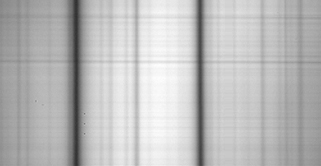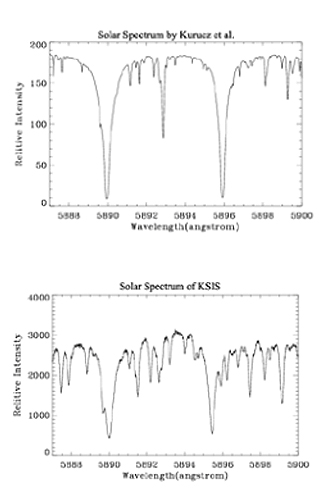KASI Solar Imaging Spectrograph (KSIS)

The solar spectroscopic telescope of KASI is a scanning type telescope which enables to observe imaging spectrograph.
Slit and grating are key functions to picture the local imaging and spectroscopic, respectively. Slit can move by a constant speed so that we can obtain the image as a function of time. Furthermore, the grating separates the Sun-light as a function of wavelength. The scanning mirror can adjust the focused Sun’s position by adjusting the reflection angle.
The filter response function of Lyot filters installed in the Solar Flare Telescope at the Mt. Bohyun is measured and adjusted by using this telescope. This telescope was to be a test base of Fast Imaging Solar Spectrograph (FISS) installed New Solar Observatory (NST) which is having the largest diameter among solar telescope in the world.
System
The telescope can be decomposed into two part. One is Dome-part which consist of both primary and secondary mirror with control motors. The other is Body-part which is composed of actual body tube and eye piece part. The eye piece part is located in the dark room. The spectroscopy is made at this dark room.
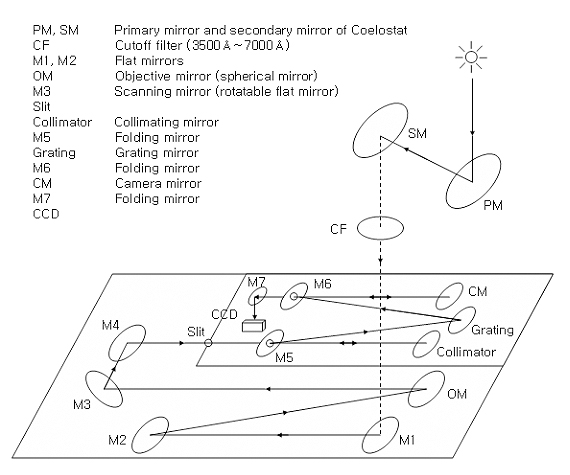
PM,SM - Primary mirror and secondary mirror of Coelostat
CF - Cutoff filter(3500Å~7000Å)
M1,M2 - Flat mirrors
OM - Objective mirror (spherical mirror)
M3 - Scanning mirror (rotatable flat mirror)
Slit
Collimator - Collimating mirror
M5 - Folding mirror
Grating - Grating mirror
M6 - Folding mirror
CM - Camera mirror
M7 - Folding mirror
CCD
- Coelostat
The coelostat is a device consisting of a flat primary mirror that is turned slowly by a motor to reflect a portion of the Sun-light continuously into a fixed telescope. The mirror is mounted to rotate so that the telescope image is stationary and non-rotating.
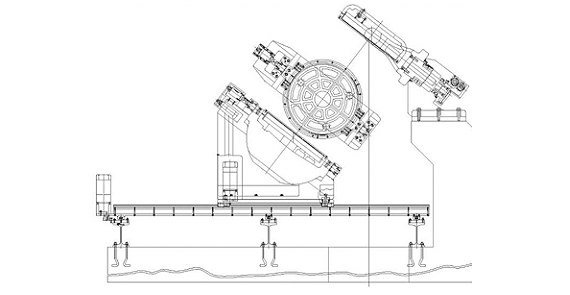
- Optical System
The optics is integrated with a 30cm primary mirror, 10 reflecting mirror to make 9 m focal length in the room, and movable slit and grating for the imaging spectrograph. We can obtain spectroscopic scanned images at a less than 0.2 Å wavelength resolution.
| Mirror | Specification |
|---|---|
| M1 (Flat Mirror) | Φ = 438 mm, focal length = 420 mm, flat mirror, cooling mirror(cutoff at 800 nm), Zerodur, λ/10 |
| M2, M3 (Flat Mirrors) M4 (Scanning Mirror) |
Φ = 300 mm, Pyrex, λ/10 |
| OM (Objective Mirror) | Φ = 310 mm, focal length = 300 mm (f/30), spherical mirror, Pyrex |
| Slit | L ≥ 1 cm ~ 5 cm W ≥ 5 μm ~ 1000 μm |
| Collimator | Φ = 160 mm, focal length = 150 mm (f/30), spherical mirror, Pyrex |
| M5 (Folding Mirror) | Φ = 170 mm, focal length = 160 mm, Pyrex, λ/10, diameter of a hole = 26 mm, distance between Slit and M5 : 500 mm |
| Grating | 600 grooves/mm, 154 ×206×30 mm3, BK7 3rd order |
| M6 (Folding Mirror) | Φ = 200 mm, focal length = 180 mm, Pyrex, λ/10, diameter of a hole = 30 mm, distance between CCD and M6 : 500 mm |
| CM (Camera Mirror) | Φ = 200 mm, focal length = 190 mm, Pyrex, λ/10, R=-9000 mm |
- Scanning Mirror
The scanning mirror reflects the Sun-light. The mirror is located at around center of the body tube so that the specific region can be identified from eye by changing the angle of reflection. The mirror installed with a rotating stage and stepping motor which is controlled by our control software.
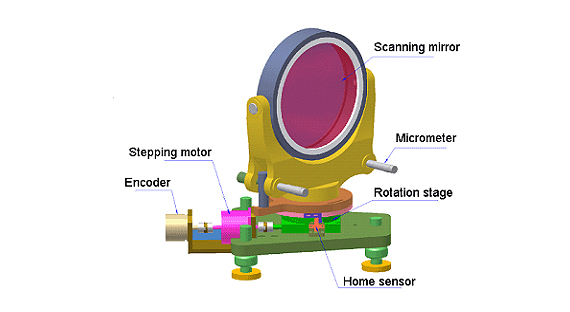
| Hardware | Specification |
|---|---|
| Rotation stage | PI M-037.00, Φ = 60 mm, >360도 Resolution : 0.12″(with servo motor) warm gear type |
| Motor Driver | Compumotor OEM750 Resolution : 50.800 pulses/round Input voltage : 24VDC - 75VDC |
| Incoder | Metronics S-40-8-6000ZV Resolution : 6,000 x 4 = 24,000 pulses |
- CCD Camera
CCD is located at the focus in the dark room. The image can be monitored and saved by using our own control software.
| Mirror | Specification |
|---|---|
| Imaging CCD | 1M15 |
| Array Dimension | 14.3 x 14.3 mm |
| Pixel Dimension | 1024 x 1024 pixel |
| Pixel Size | 14 x 14 ㎛ |
| A/D Resolution | 12 bits |
| Interface | RS-422 |
| Data Acquisition Time | ~ 1/15 sec |
[ CCD Quantum Efficiency ]
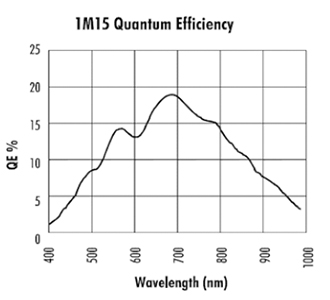
Filter Test
We test the Lyot filter installed at the SOlar Flare Telescope (SOFT) by every year to maintain the performance of the SOFT by optimize the filter response at the interested wavelength.
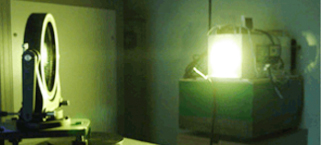
Filter test landscape. The Lyot filter should be collimated to the Sun-light path.
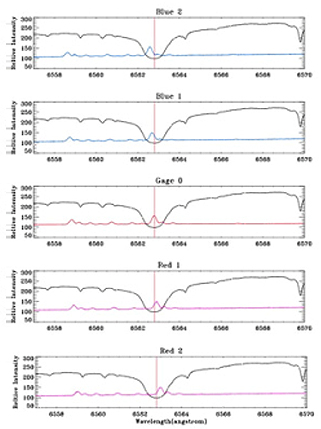

The filter response function is measured the filtered Sun-light.
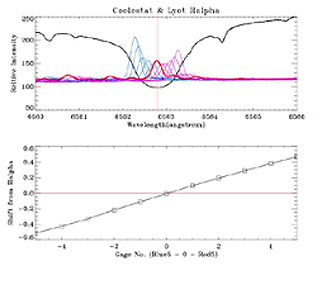
The filter response should be shifted by adjusting the Lyot filter itself based on the difference of response to the reference spectrum
Spectrograph
H-alpha 6562.8 Å
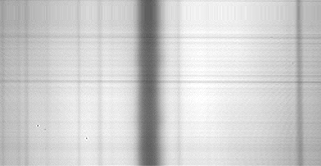
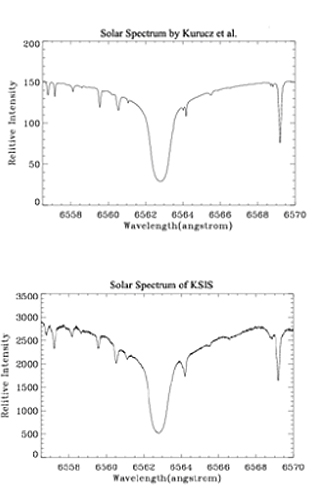
Sodium D1 5898 Å, D2 5890 Å
